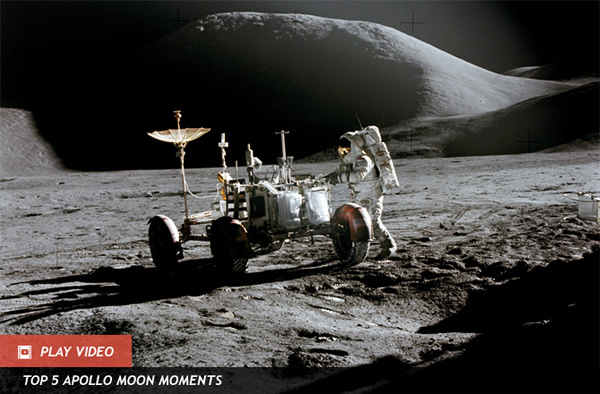42 Years Since First Apollo Moon Rover Joyride
42 Years Since First Apollo Moon Rover Joyride
Some of the best videos from Apollo missions might be those of astronauts gunning it in their lunar rovers, the lightweight vehicles that took them miles across the moon’s surface during short sojourns. What’s really amazing about the lunar rover, however, is that it was carrying astronauts around the moon less than two years after NASA awarded the contract for its construction.
It didn’t take a genius to realize that having some kind of wheeled transportation would help Apollo astronauts make the most of their time on the surface. Anyone can travel further in a car than on foot, particularly when they’re trying to move in a bulky pressure suit in one-sixth Earth gravity.
Early rovers were imagined with the astronauts’ comfort in mind. They were roving habitats. Astronauts could travel between interesting science site in a pressurized vehicle, suiting up and maneuvering in their bulky suits only when they arrived at their destination. Creative engineers took this roving habitat further, envisioning fleets of habitats roving, jumping, and even flying around the Moon with astronauts on board.
But it wasn’t until 1969 that NASA began to work on rover for an actual mission, and the impetus came from Wernher von Braun. He established a Lunar Roving Task Team at NASA’s Marshall Spaceflight Center with the goal of developing an aid for astronauts’ moonwalks. At the end of May that year, NASA signed off on the program. At the start of 1970, the agency awarded a contract to Boeing to build the lunar rover.
Designing a vehicle to rove the moon wasn’t without its challenges. Engineers had to design a something that could drive through soft lunar dust, travel over a rocky and varied terrain, survive the punishing temperature extremes of the moon’s surface where there’s 500 degrees Fahrenheit difference between light and shadow, operate in a vacuum, be light enough to carry to the moon, and be built in such a way that astronauts in cumbersome EVA suits could drive without getting lost.
And according to von Braun’s original call for a rover in 1969, he hoped a vehicle would fly by 1971. It had to be done, quickly, cheaply, and perfectly. There wasn’t going to be a test drive.
It was a tall order, but Boeing delivered. The final rover weighed just 460 pounds and could be folded into an area just four cubic feet on the Lunar Module’s descent stage.
On July 31, 1971, Apollo 15 astronauts Dave Scott and Jim Irwin deployed the first lunar rover. As they lowered it towards the surface, springs deployed the wheels automatically. The astronauts had just to deploy the seats and the footrests and it was ready to drive.
The final design was an open vehicle made of lightweight aluminum. Battery operated with individual motors to control each reinforced spun aluminum, fender-covered wheel, a T-shaped accelerator located between the two nylon mesh seats enabled the astronauts to drive with their bulky gloves on. A suite of onboard instruments – odometers, attitude indicators, and instruments that measured the sun’s shadow ensured the crew could drive without getting lost. The rover would tell the how far they’d traveled and in what direction, so they only had to retrace their steps. Cameras on board captured videos and images.
The rover was a success; the Apollo 15 crew traveled as far as 3.1 miles from their Lunar Module whereas the previous crew, Apollo 14, ventured just under a mile from their LM. Apollo 17, the last Apollo mission, set records in the lunar rover. The crew, Gene Cernan and Jack Schmitt, traveled 4.5 miles from their LM and drove just faster than 11.5 miles per hour. But it was the Apollo 16 moonwalkers, John Young and Charlie Duke, who put the rover through its paces in the first and only lunar rover “Grand Prix,” which onboard cameras captured in all its speeding glory.
Image: Astronaut James B. Irwin, lunar module pilot, works at the Lunar Roving Vehicle during the first Apollo 15 lunar surface extravehicular activity (EVA) at the Hadley-Apennine landing site on July 31, 1971. Credit: NASA(Jul 31, 2013 01:53 PM ET // by Amy Shira Teitel)












